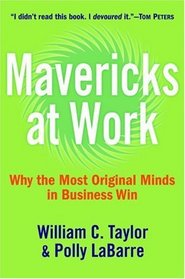Search -
Mavericks at Work: Why the Most Original Minds in Business Win
Mavericks at Work Why the Most Original Minds in Business Win
Author:
In Mavericks at Work, Fast Company cofounder William C. Taylor and Polly LaBarre, a longtime editor at the magazine, give you an inside look at the "most original minds in business" wherever they find them: from Procter & Gamble to Pixar, from gold mines to funky sandwich shops. Want to stop doing business as usual? Then take some ... more »
Author:
In Mavericks at Work, Fast Company cofounder William C. Taylor and Polly LaBarre, a longtime editor at the magazine, give you an inside look at the "most original minds in business" wherever they find them: from Procter & Gamble to Pixar, from gold mines to funky sandwich shops. Want to stop doing business as usual? Then take some ... more »
ISBN-13: 9780060779610
ISBN-10: 0060779616
Publication Date: 9/1/2006
Pages: 336
Rating: 3
ISBN-10: 0060779616
Publication Date: 9/1/2006
Pages: 336
Rating: 3
3.8 stars, based on 3 ratings
Publisher: William Morrow
Book Type: Hardcover
Other Versions: Paperback
Reviews: Amazon | Write a Review
Book Type: Hardcover
Other Versions: Paperback
Reviews: Amazon | Write a Review
Genres:
- Business & Money >> General
- Business & Money >> Management & Leadership >> Leadership & Motivation
- Business & Money >> Management & Leadership >> Management
- Business & Money >> Marketing & Sales >> Marketing >> General





